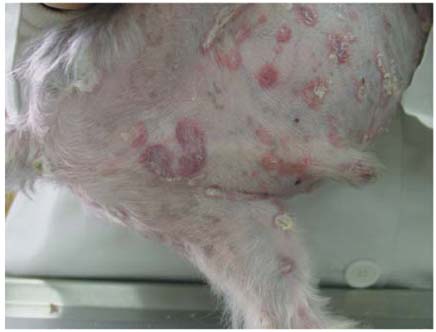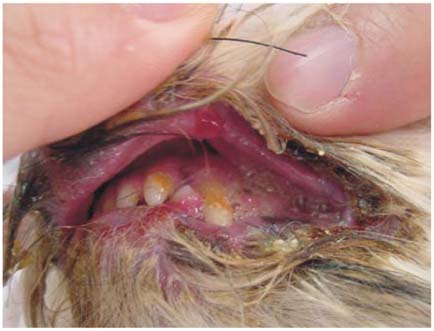J Vet Sci.
2006 Mar;7(1):97-99. 10.4142/jvs.2006.7.1.97.
Epitheliotropic cutaneous lymphoma (mycosis fungoides) in a dog
- Affiliations
-
- 1Department of Veterinary Internal Medicine, College of Veterinary Medicine, Seoul National University, Seoul 151-742, Korea. hyyoun@snu.ac.kr
- 2Department of Veterinary Pathology, College of Veterinary Medicine, Seoul National University, Seoul 151-742, Korea.
- 3Department of Veterinary Clinical Pathology, College of Veterinary Medicine, Seoul National University, Seoul 151-742, Korea.
- KMID: 1103565
- DOI: http://doi.org/10.4142/jvs.2006.7.1.97
Abstract
- A seven-year-old castrated male Yorkshire terrier dog was presented for a recurrent skin disease. Erythematous skin during the first visit progressed from multiple plaques to patch lesions and exudative erosion in the oral mucosa membrane. Biopsy samples were taken from erythematous skin and were diagnosed with epitheliotropic T cell cutaneous lymphoma by histopathology and immunochemical stain. In serum chemistry, the dog had a hypercalcemia (15.7 mg/dl) and mild increased alkaline phosphatase (417 U/l). Immunohistochemistry was performed to detect parathyroid hormone-related peptide (PTH-rP) in epitheliotropic cutaneous lymphoma tissues but the neoplastic cells were not labeled with anti-PTH-rP antibodies. The patient was treated with prednisolone and isotretinoin. However, the dog died unexpectedly.
MeSH Terms
Figure
Reference
-
1. Brown NO, Nesbitt GH, Patnaik AK, Gregory MacEwen E. Cutaneous lymphosarcoma in the dog: A disease with variable clinical and histologic manifestations. J Am Anim Hosp Assoc. 1980. 16:343–345.2. Campbell KL. . Small Animal Dermatology Secrets. 2004. Philadelphia: Hanley & Belfus;435–440.3. Choi US, Jeong SM, Kang MS, Jung IS, Kim DY, Lee CW. Cutaneous lymphoma in a juvenile dog. Vet Clin Pathol. 2004. 33:47–49.
Article4. Donaldson D, Day MJ. Epitheliotropic lymphoma (mycosis fungoides) presenting as blepharoconjunctivitis in an Irish setter. J Small Anim Pract. 2000. 41:317–320.
Article5. Foster AP, Evans E, Kerlin RL, Vail DM. Cutaneous T-Cell lymphoma with Sezary syndrome in a dog. Vet Clin Pathol. 1997. 26:188–192.6. Gregory MacEwen E, Withrow SJ. Small Animal Clinical Oncology. 2001. 3rd ed. Philadelphia: Saunders;38–39. 5587. McKeever PJ, Grindem CB, Stevens JB. Canine cutaneous lymphoma. J Am Vet Med Assoc. 1982. 180:531–536.8. Morrison WB. Cancer in Dogs and Cats. 2002. 2nd ed. Jackson: Teton Newmedia;643663–665.9. Obagi S, DeRubertis F, BrownMPA-C L, Deng JS. Hypercalcemia and parathyroid hormone related protein expression in cutaneous T-cell lymphoma. Int J Dermatol. 1999. 38:855–862.
Article10. Scott DW, Miller WH, Griffin CE. Muller & Kirk's Small Animal Dermatology. 2001. 6th ed. Philadelphia: Sanunders;1333–1338.11. Thrall MA, Macy DW, Snyder SP, Hall RL. Cutaneous lymphosarcoma and leukemia in a dog resembling Sezary syndrome in man. Vet Pathol. 1984. 21:182–186.
Article12. White SD, Rosychuk RAW, Scott KV, Trettien AL, Jonas L, Denerolle P. Use of isotretinoin and etretinate for the treatment of benign cutaneous neoplasia and cutaneous lymphoma in dogs. J Am Vet Med Assoc. 1993. 202:387–391.
- Full Text Links
- Actions
-
Cited
- CITED
-
- Close
- Share
- Similar articles
-
- Mycosis Fungoides with Coincidental Ureter Cancer
- A Case of Transformation of Mycosis Fungoides to Large Cell Lymphoma
- A Case of Granulomatous Mycosis Fungoides
- A Case of Ki-1 Positive Large-Cell Lymphoma Transformed from Mycosis Fungoides
- Coexisting mycosis fungoides and Hodgkin's disease as a composite lymphoma: a case report






